What is the best recipe for mashed potatoes?
In my family, mashed potatoes were one of the first things I learned to make. It was also one of the first things I taught my daughters to cook.
Mashed potatoes seem to appeal to almost everyone. But here’s the tricky thing.
Ask ten people how they like to prepare their mashed spuds, and you’ll likely get ten different answers. That’s because, as with all food, defining the “best” mashed potato is a very subjective thing.
Mashed potatoes are one of those side dishes that you probably had more times than you can count when growing up, both at home and at the school cafeteria.
And the way your mom made them – whether red potatoes smashed with their skins on or some mysterious reconstituted potato flakes – is probably the way you like them today.
Or maybe you didn’t like your mom’s version of mashed potatoes and grew up thinking of them as bland, gummy, watery, or just plain gloppy. And then, when you had mashed potatoes at your girlfriend’s or boyfriend’s house or a restaurant, you suddenly realized that mashed potatoes were fantastic. Sorry, mom.
But what happens when a reconstituted potato-loving person marries a red potato mashed with skins person, and they look at each other for the first time, and one says, “Hey, how about mashed potatoes for dinner tonight?”
“Oh! My favorite!” says the other. What happens next could get ugly.
Marriage Potato Bliss
Fortunately, my wife and I have the same taste in mashed potatoes. However, she makes them utterly different from my mom who used a mixer to whip tons of air into hers.
My wife prepares them with an old fashion tomato masher that she either found at a garage sale or grabbed from her mom’s kitchen on the way to college.
Over the years, I have watched many friends make their mashed potatoes, and it’s incredible how many different ways there are to smash these tubers. Below we will look at how to choose the best potato, how to cook them, how to mash them and then how to season and add additional flavor.
But first, here is my basic recipe for mashed potatoes.
Now Let’s Consider A Few Options When Mashing Potatoes
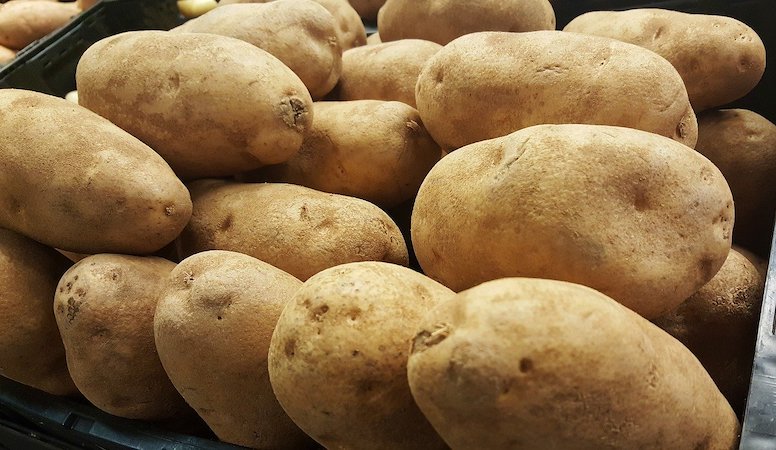
Choosing the Right Potato to Mash
This post looks at many options for preparing great mashed potatoes. After checking out some of these tips, you can find my basic mashed potato recipe below.
A potato is a package that contains starch, sugar, and water along with some nutrients, especially in the skins. But, there are many varieties of potatoes, and they differ in the proportions of each component.
Most cookbooks tell you to use high-starch potatoes for mashing, like the russet or the slightly less but still starchy Yukon Gold. Starches swell at about 150°F, so the more starch your potato contains, the fluffier your mashed potatoes will be.
That makes sense to me, but when I think I have a good handle on the right potato to mash, I hear otherwise.
My friend, who happens to be a chef, likes to mash waxy (lower-starch) potatoes like the thin-skinned red or round white varieties. He says that waxy potatoes absorb less water, hold up better while cooking, and have more flavor than high-starch potatoes.
I had to test out his theory, so I mashed two pounds each of starchy and waxy potatoes. I cooked and then mashed them precisely the same way with the same ingredients.
I found it a bit harder to mash the waxy potatoes, but with a little extra elbow grease, I got them just as smooth as the starchy potatoes.
As it turned out, I liked the flavor of the waxy potatoes better, but my wife thought they tasted waxy and preferred our usual russets. So if the first word that comes to your mind to describe mashed potatoes is “starchy,” then you might want to switch to mashing waxy potatoes.
And this makes sense. A potato with less starch is less apt to taste starchy than a potato with more starch.
What about the mashed potatoes’ color?
I love to mash Yukon Gold potatoes because of their rich, buttery color and flavor, but these contain a relatively high amount of starch, especially when compared to waxy potatoes.
My chef friend, Chef Ricco, said that to reduce the starch content in starchy potatoes before mashing, peel and quarter them the night before and let them soak in cold water overnight.
After the long soak, the water will be very cloudy because of the excess starch. Just pour that water away, add fresh water, cook, drain, and then mash.
But coming back to personal taste and those ten people we asked about perfect mashed potatoes, some people (like my wife) like starchy mashed potatoes. Not gummy, of course, but nice and fluffy and starchy. In that case, skip the soak.
In the end, you will probably need to experiment with a few different varieties of potatoes to come up with your favorite for mashing. You might even find that you like to mash a mixture of high and low-starch potatoes to find your ideal.
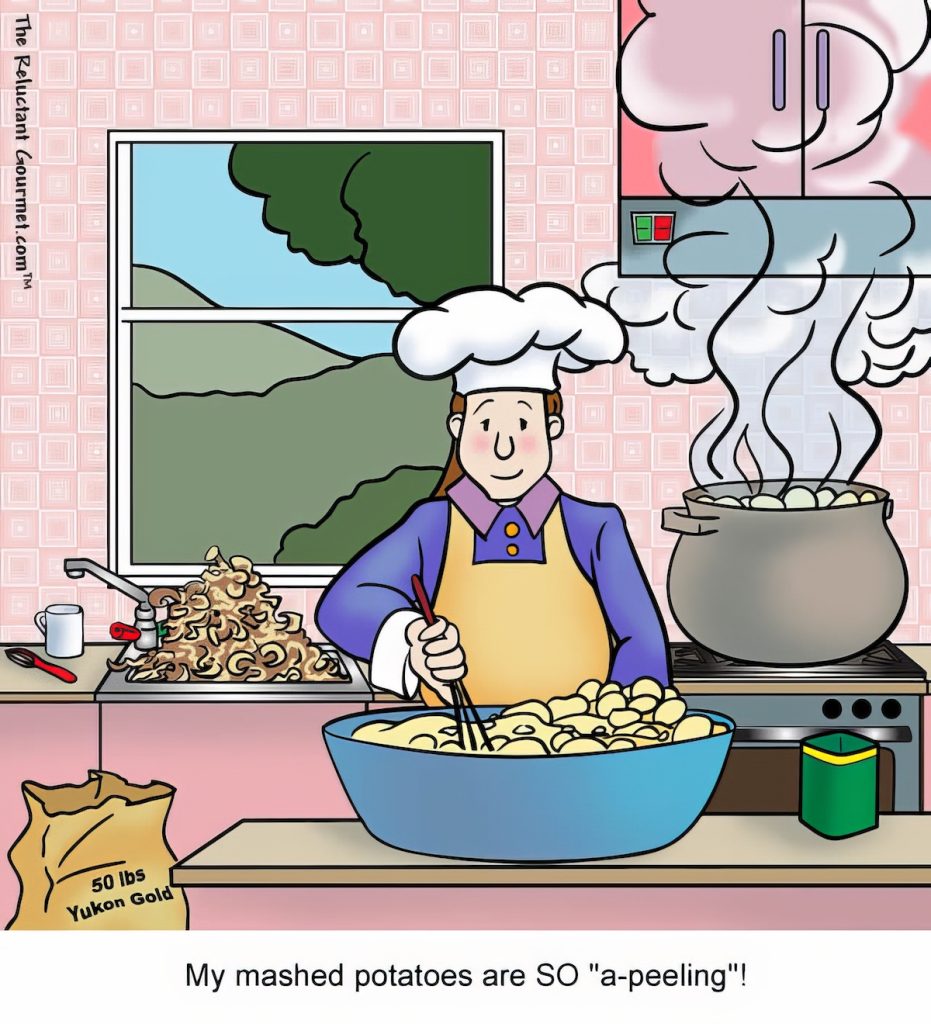
To Peel or Not to Peel
I have witnessed heated debates over this issue. For example, some people call potatoes mashed with the peels still on “smashed” potatoes. The smashed camp will usually say something about the texture variation being appealing.
That there are more nutrients in the skin and it’s best to leave the skin on. That they look better on the plate.
People on the “mashed” side talk about how the smooth, regular texture is one of the major appeals of mashed potatoes. That lumpy mashed potatoes are nothing more than under-mashed potatoes, and that “smashed potatoes” is just a dish made up at restaurants that didn’t want to take the time to mash the potatoes thoroughly.
I can see both sides of the issue, but I refuse to take sides. Each has its place. To me, it depends on personal taste and also what else I’m serving. For example, smashed potatoes are a little more rustic, and smooth mashed potatoes are a bit more refined.
So, I’d probably serve mashed potatoes with a nice beef tenderloin, whereas I might smash some potatoes to go with grilled sirloin.
When I was growing up, my dad grew potatoes in our backyard, and I came to appreciate freshly harvested, home-grown new potatoes mashed with their skins on. In my book, there’s nothing better. But that doesn’t mean that I always leave the skins on.
Again, it depends on the circumstance and on what potatoes are available. Believe me, though, if I ever plant potatoes in the backyard with my girls, we mash them with the skins on!
If you choose to leave the skins on, use new potatoes or thin-skinned red potatoes – I tried mashing russets with the skins on, and the result wasn’t too pleasant.
The thick skins were too much of a contrast to the creamy potatoes. And, whether or not you choose to leave the skins on, always wash your potatoes well and cut out any eyes.
Cooking them with the skins in the pot, but not on the potato
I recently read about this exciting technique: peel the potatoes, gather them, and tie them into a cheesecloth bag. Leave the bag in the pot to boil with the potatoes and then toss it out before mashing. I am not sure why they did it that way.
Maybe it was just the writer’s family tradition, but it seems that some of the flavor and nutrients in the skins leach into the water and then are drawn into the potatoes during the cooking process. So maybe this technique offers the best of both worlds.
Creamy, smooth mashed potatoes with extra potato flavor and nutrition from the skins–sounds like the best of both worlds to me!
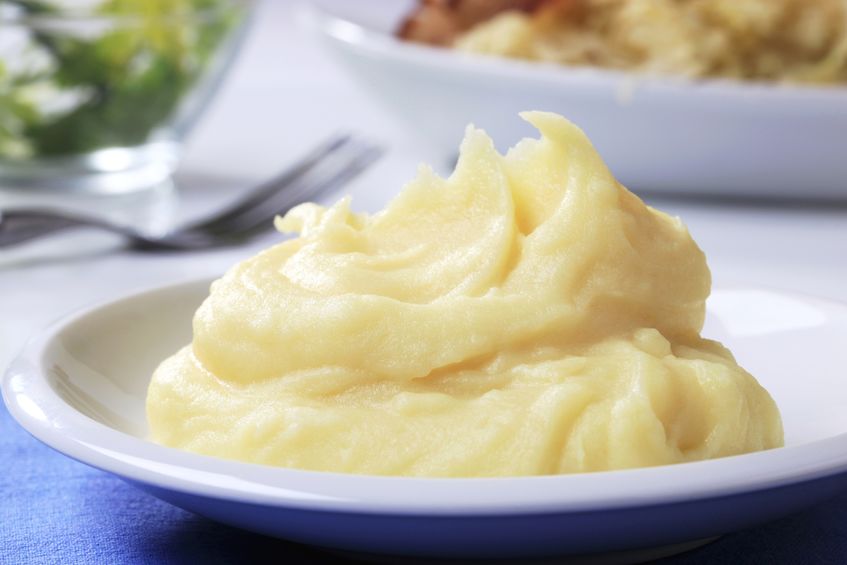
How to Boil a Potato for Mashing
I’ve always started my potatoes in cold water. My mother did it that way. I do it that way, and I’ve taught my girls to do it. But I never stopped to wonder if there was a good reason to start potatoes in cold water until someone asked me that in an email.
Keep in mind I’m not a professional chef. I’m just a guy who wants to be able to make a good meal. When people email me questions like that, I generally don’t have the answer. I’m not a chef, so I first find a chef and ask them.
So, when that email came into my inbox, my first thought was, “well, who wants to cook in water that has been sitting around in a hot water tank?” I didn’t think it was the best, or even correct, answer, so I asked a chef friend, David Nelson.
By his tone of voice, he thought I was crazy and said that he didn’t think it would matter but would do some further research.
He found out from The Meat and Potatoes Cookbook to use cold water, but they didn’t offer a reason. So now he was intrigued and posted the question on a chef cooking forum.
Now, here’s where things start to get a bit scientific, so I’m just going to give you the gist of it to spare you the headache I got.
Starting the potatoes in cold water allows for more even cooking as the temperature of the potatoes rises slowly.
Harold McGee, the author of On Food and Cooking, says that starch granules gelatinize, or swell up, between 137°F and 150°F. So if you throw the potatoes in already boiling water, the outside starch granules will gelatinize on contact with the water, effectively blocking the water from penetrating farther into the potato.
So, it seems as if there are at least two excellent reasons you should start your potatoes (or any starchy vegetable) in cold water. Now, this doesn’t mean that you can’t bring your potatoes up to a gentle boil; it just means that you should start them cold so they can gradually come up to temperature and cook (gelatinize, in this instance) evenly.
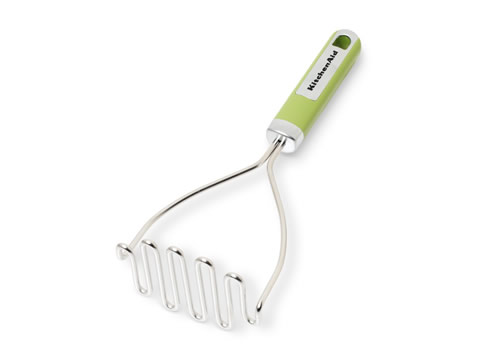
What Tool to Use to Mash Potatoes
Like the answer to most questions about cooking, the right tool for the job depends on your taste. If you like very light and fluffy mashed potatoes with no lumps, there’s a tool for that. If you like mashed potatoes with some texture, there’s a tool for that, too.
I have four different tools in my kitchen that I can use for mashing potatoes. I also have some tools that some people might want to use but shouldn’t.
First, the list of approved tools for the job:
- A wire masher whose mashing surface looks like the electrical coil in your oven is the one I use most often.
- A stainless steel masher whose mashing surface looks kind of like a miniature manhole cover–solid stainless steel with holes for mashing punched out.
- a ricer, which looks like an over-sized garlic press and
- an electric mixer, either hand or stand
Wire Masher
I bet almost everyone in America has a wire potato masher in their gadget drawer. The only exception might be low-carb households, but even then, you might want to mash some cauliflower!
The wire masher is generally my go-to tool for mashing potatoes. It’s very versatile: mash a little to have potatoes with some lumps and chunks in them–it’s ideal for making smashed potatoes–mash a lot and get perfectly smooth mashed potatoes.
Since the masher has a relatively small mashing surface (after all, it’s just a thick wire), a wire masher will leave your potatoes relatively light in texture since it doesn’t crush too many delicate starch granules.
Stainless Steel Masher
A stainless steel masher has a long or U-shaped handle that supports the mashing disc on the end. The disc has many little holes (maybe 1/4″ to 1/3″). Mash the masher down through the potatoes, and the potatoes squish through the little holes.
This can require some elbow grease. I think it’s a little too much work for a side dish, but lots of my friends swear by theirs.
You can make either smashed or mashed potatoes with this type of masher, as well, but the potatoes will be a little heavier since the increased surface area of the masher tends to crush more of the starch granules than the wire masher.
Potato Ricer
Forcing cooked potatoes through a ricer is akin to pressing garlic. Place the cooked potatoes in a cylindrical enclosure fitted with a metal die positively riddled with holes at one end, push the plunger, and force the potatoes through the little holes.
The resulting potatoes will be completely smooth and light in texture, making it very easy to incorporate the butter and/or milk or other liquids.
Although silky smooth, riced potatoes can be a little dense. No air gets incorporated as with the other two mashers mentioned above.
With those mashers, the repeated up-and-down mashing action incorporated air, lightening the potatoes.
With a ricer, it’s once-through and done, so almost no air is incorporated. I like them that way (along with many other ways!), but my wife thinks they’re too heavy. See why I learned to cook?
I recently received an email from a home cook who says he uses a ricer with skin-on small new potatoes. One press and the potato is forced through the die, leaving the skins behind in the ricer. I’m going to have to give that one a try!
An Extra Step – If you like extra air incorporated into your mashed potatoes, beat them for a minute with a whisk. This will lighten the potatoes a bit.
If your significant other likes lighter mashed potatoes and you like them denser, whisk their portion, and everyone is happy.
Electric Mixer
Mashed potatoes made with a hand mixer are the mashed potatoes of my childhood. This is the way my mom used to make them. I can still see her standing there, holding the mixer in one hand and periodically adding butter and milk.
This mashed potato style is more accurately called whipped potatoes since a lot of air is incorporated while beating. A chef friend told me this is how restaurants often mash their potatoes. It’s quick and increases the potatoes’ volume, making it economical.
What looks like a lot of mashed potatoes is partly air bubbles. He also said that whipped potatoes hold up well on a steam table and are great for piping out of a pastry bag.
Again, some people find whipped potatoes their favorite kind–light and almost fluffy. Others will find them over-processed. Again, it’s all a matter of taste. Make them the way you like them!
The Food Processor–Not Approved for Mashed Potatoes
The food processor is the enemy of starchy vegetables everywhere. So while you’ll want to use it to make tapenade, pesto, or hummus, please do not use it to mash your potatoes.
While it seems like a good idea to make short work of the job, the exceptionally high speed at which the blade spins smashes the starch granules, and what you end up with is a gluey, starchy, nasty mess.
Choose Your Style
Now you have some options for mashing potatoes. If you want lighter mashed potatoes, whisk them or use a mixer. If you like dense, smooth mashed potatoes, use the ricer. It’s all about the tool you choose to use.
Just like a painter will get a different result with each brush he chooses, you’ll end up with a different version of the same dish, depending on what mashing tool you choose.
Best Mashed Potatoes Recipe
Ingredients
- 2 pounds potatoes either starchy - waxy or a mix of both
- 1 teaspoon salt
- 7 tablespoons unsalted butter
- 1 cup half and half
- freshly ground black or white pepper - to taste
Instructions
- Cook the potatoes until fork tender.
- Mash with salt, butter, and half and half.
- Season with freshly ground pepper
- Now that we have a working list of ingredients and a method, there are plenty of other decisions to make.

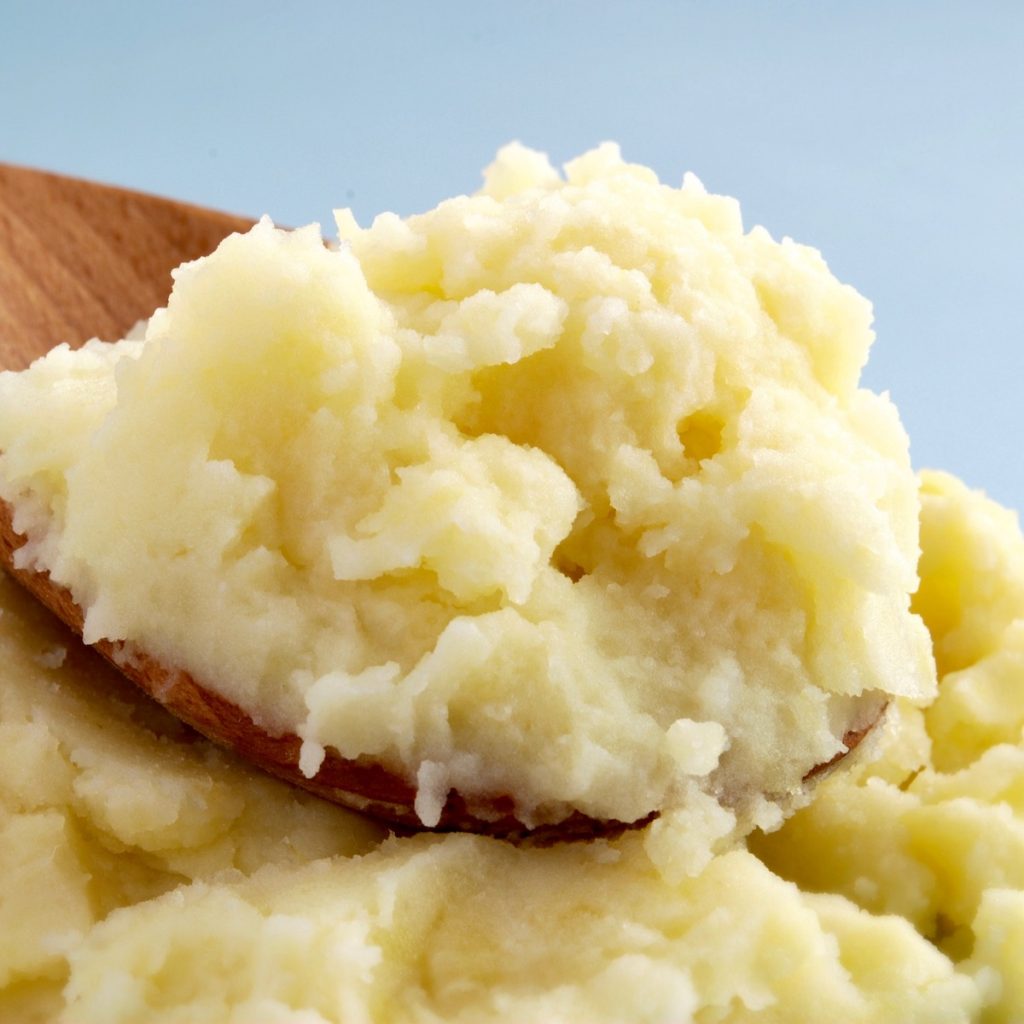




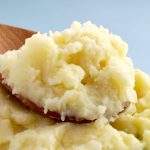
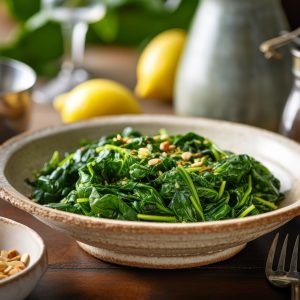
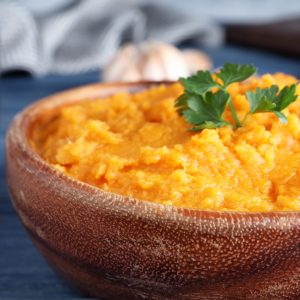
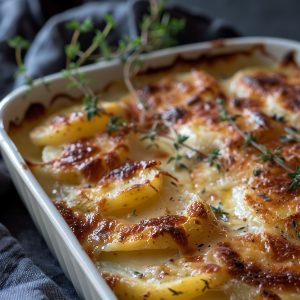

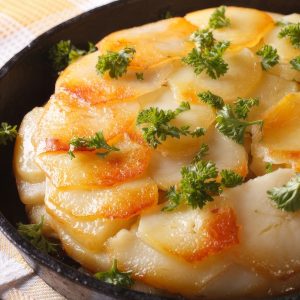
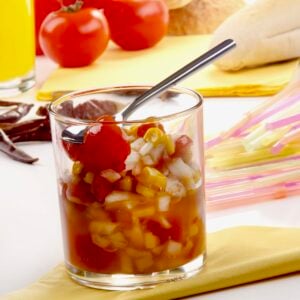
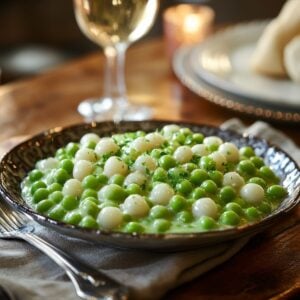
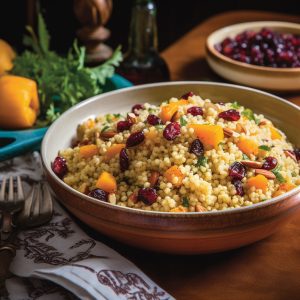


52 Responses
My addition to how to make great mashed potatoes, is to leave the skins ON, cut them in half or quarters, and cook until tender. Then, drain, add butter, salt to taste, and pepper, and about 1/4 to 1/2 cup of milk, depending on how many potatoes you have used. Then, add 1/2 tsp. of Baking Powder, and mix with mixer until fluffy. I, also, add minced onion, on occasion–yum! The baking powder is a French way of doing things, but it does make a difference, and “vive la difference!” Leaving the skins on adds a terrific texture, plus added vitamins–plus, you don’t have to peel the potatoes that way!
Everyone’s suggestions have been great (especially the pickled walnut one) but I find that instead of milk, using a combination of condensed milk, and regular milk makes mashed potatoes AMAZING! Especially if you use a mixer to blend them.
Here are 2 alternative ways I like to enhance my mashed potato:
1. Crush a clove or 2 of garlic in while mashing.
2. Stir in a few teaspoons of black olive paste.
I visited the Idaho Potato web site for tips on mashing potatoes. They suggest placing a quarter of a lemon in the cooking water to prevent potatoes from breaking up. Cook them in their skins to prevent water logging. After cooking, pull the skin from the end of the potato to remove easily. While mashing, add WARM milk to the potatoes gradually to gauge consistency; then add any other favorite condiments.
Hello! My addition to how to make great mashed potatoes, is to leave the skins ON, cut them in half or quarters, and cook until tender. Then, drain, add butter, salt to taste, and pepper, and about 1/4 to 1/2 cup of milk, depending on how many potatoes you have used. Then, add 1/2 tsp. of Baking Powder, and mix with mixer until fluffy. I, also, add minced onion, on occassion–yum! The baking powder is a French way of doing things, but it does make a difference, and “vive la difference!” Leaving the skins on adds a terrific texture, plus added vitamins–plus, you don’t have to peel the potatoes that way! Christie Chiomento
Once My potatoes are softened,I remove them from the saucepan, strain them, then put them in the food processor with a pinch of nutmeg, a hunk of mature cheddar cheese, and a dash of Worcestershire sauce.
Wow, they drive my husband wild…yeahhh.
I’m here at your web page and I’m going to take a couple of swipes at your mashed potatoes, but not TOO many!
1) I think that if you are using Yukon golds or Finns, it is better to leave them whole. My theory is that when you quarter them they loose starch into the water.(I am assuming you have fist size or slightly larger).
2) I use a masher but I cook them a bit longer and they never a lump. I think people undercook their mashed potatoes. they should not be falling apart, but on the other hand I notice no flavor degradation by cooking until VERY soft. I think this is a better way to get rid of lumps, then ricing.
3) and NOW for the most controversial part: I use half and half rather than milk. I am bad and evil, but it tastes so GOOD!
4) Also, if you want to pique the sweetness, try throwing in one small quartered parsnip or add more if you like the flavor.
I saute 2-3 carrots & 1 onion in butter – make a puree – add a couple of slices of american cheese and mix in mash potato mixture top with parmesan shredded cheese, a bit of drizzled butter and place under broiler until golden.
Great Web site!!! Regarding your mashed potatoes – my preference is more butter, less milk. Lea Curry’s suggestion of some parsnips is good – as an alternative piquanter I like a heaped teaspoon of hot English mustard. Regards Harry Ventriss
More butter = more fat
Less milk = reduction in bone density
Hi Reluctant Gourmet — from Allan Taylor in Adelaide, Australia
I admit that sometimes I add cream to them when, after mashing, I convert the potato into a puree with a hand-held electric blender. Yummy The next step is presentation, which you neglect to mention. On the dinner plate, if served as such, upon a white cone of potato I add on top half a pickled walnut. These are jet black and have a striking flavor contrast to the potato. If the mashed potato is served in a large bowl at a dinner party I use a surrounding ring of pickled walnuts (which go well with roast meats) to provide a culinary sight worthy of a king. Regards Allan Taylor
You’re missing a key ingredient! Cream Cheese! You’ll be licking your masher clean!
Also, to the person who suggested half & half, try using fat free evaporated milk. You’ll get that wonderful creamy “fat” flavor, but. . . . . the grams of fat just aren’t there! Try it, you’ll love it! “The Trotting Gourmet”
Mashed potatoes are my favorite food, and I?ve recently found a great source of information on mashed potato preparation when I came across your mashed potato recipe on ReluctantGourmet.com. I?m writing to you to suggest ideas to further develop your mashed potato recipe found on your site. You show a thorough understanding of the art of cooking mashed potatoes, without being condescending, and the recipe along with your bottom line could benefit from a few adjustments.
The recipe?s audience is composed of anyone interested in making excellent mashed potatoes. You succeed in helping people make perfect mashed potatoes by pointing out that the preferences of the reader will alter what they perceive as the perfect bowl of mashed potatoes.
The recipe is divided into three sections: a theoretical explanation of mashed potato preparation, a basic recipe, and comments from visitors. Each section serves an important function and enhances the reader?s ability to make perfect mashed potatoes. Anyone interested in making perfect mashed potatoes will be interested in the theoretical explanation of mashed potato preparation. This section helps the reader identify the nuances of the process and encourages the reader to experiment with these nuances in their pursuit of perfect mashed potatoes.
It is clear that you have a great deal of knowledge on how to make perfect mashed potatoes, and a knack for explaining to others how to do so themselves. This is an excellent recipe, and I plan on taking full advantage of it in my quest for perfect mashed potatoes.
If you REALLY like mashed or smashed ‘tators—add a tablespoon of mayo!
Never heard of that Alice and will give it a try.
Apparently, individual tastes, when it comes to mashed potatoes, can vary widely. I disagree mostly with your contributors. Their results are what we in the Midwest would term ‘whipped potatoes’, something that is to be studiously avoided.
I would only use mashed potatoes with gravy – never with butter – and they should be slightly dry and textured. (My ex-wife, however, always said that my ‘perfect’ potatoes were ‘lumpy’. (Hers were like library paste!)) This is probably a subject that no one will completely agree on.
First, I only use peeled, quartered, Idaho baking potatoes. (I have never found any use for red potatoes. And that includes potato salad.) Often I include a piece of rutabaga or parsnip with the potatoes, but it will need a bit of a head start. When they are fork-tender I drain them and return them to the pot, but not under any heat. (I reserve some of the starch water for the gravy which is a simultaneous operation.)
I crush the potatoes once with a masher, add the milk or half & half, and then let them sit for a couple of minutes so we’re not mixing cold with hot. The ensuing mashing is comprised of a few quick strokes so as not to gum things up. (Much like the care one would take in the delicate mixing of a meatloaf by keeping things aerated.) All other seasonings are in the gravy.
If I ever crave butter/parsley/garlic/sour cream/ or anything like that on a potato, I would either bake them in hot resin or boil new potatoes in the spring. Mashed is not where that stuff belongs. Sorry.
At least you’re not being condescending about somebody else’s preference for a mashed potato. Oh wait…
I like to add a half cup of cream cheese to my recipe and season with garlic salt and pepper. That’s my input.
try to add a little garlic powder little bit white pepper and a drizzle of nutmeg / and make it even fancier mix some cooked cauliflower and fried bacon pieces/ mix all together and put casserole for 5 minutes or so in oven on 350/ good luck good eating
Your recipe is wonderful. Another suggestion: I sautee’d shallots until crisp and add them to mashed potatoes with a dash of olive oil – Yum!
People think you made something special. The shallots are very flavorful.
i like potatoes. And this font.
That was cute & funny.
Mashing potato…we were both right…
expert 🙂
Hi. I am enjoying your recipes. It’s a little harder for me because I am lactose intolerant, diabetic, celiac and have diverticulitis. Anyway, I add turnips to my mashed potatoes – makes them very tasty and more healthy. If you try this, I’d love to know how you liked it.
I just wish to say that your blog post is well written.
Hopefully I can follow up with your other forthcoming post if I have time.
Thanks and stay sharp to carry on with the writting.
Consider this recipe, where the ratio of potato to butter is 2 to 1. I tried it, but felt it was just too much butter (and I love butter). Now I go with 3 to 1 or 4 to 1 (depending on how much butter I have) and they are the best mash potatoes I have ever had.
Great advice and so thorough. I appreciate the thought behind your post. Thanks!
I love garlic mashed potato. I boil russet with about 3-4 cloves of garlic and then mashed. The garlic is soft and yummy in the potato add your butter and milk according to the consistancy you want and yum. So easy and you can add more or less garlic cloves depending on taste.
Sounds delicious Tammy. Thanks for sharing.
The point about ‘with the skins on’ is not simply about taste and texture. Nearly all the ‘goodness’ (Vitamin C, particularly) in a potato is right under the skin, so when you peel potatoes (and whether you put the peels in a bag with the potatoes or not), you lose most of the nutrition.
If you like smooth mashed potato (without the skins), the most nourishing method is to cook the potatoes with the skins on (it’s best to use medium-sized and uniform potatoes) and then peel off just the brown/red skin with the aid of a knife. It often slips right off, especially if it’s the thicker kind of skin you find on a russet.
Gary, you left nothing unturned in this thorough, comprehensive post. Excellent work!
Thank you very much Brooks.
Hi, I grew up in farmland ,ontario and We were taught that the general rule for cooking veggis is this.
If it grows below the ground you start it in cold water then bring to a boil. If it grows above the ground, you start to cook in boiling water. I don’t know why but if it worked for my granny in the early 1900’s there must be something to it.
What a great general rule. Thanks
I’m in my 60’s and married 40 some years. During my time of cooking I used Instant Mashed Potatoes which tasted pretty good… I worked full time and raising chiildren with hubby working shift work and I worked around his schedule… I just started making Home Cooked mashed potatoes and followed this recipe leaving some skins on for flavor and vitamins… YUMMMO Missed out on this flavor since a kid where I had a stay at home mom. THANKS… I’m feeling special again
Thanks for letting me know Spikey.
mash and rutabaga, try it, cook the rutabaga with your potato and mash just as you would with out, love it, gives it a flavor.
I steam my potatoes whether I eat them whole or mashed. Wonderful!
Firstly, thank you so much for sharing your amazing and creative knowledge regarding “The Art of Perfect Mashed Potatoes”, you have provided me with all of the information I was seeking in one shot! I’ll be attempting to create a nice fluffy dish for our Thanksgiving meal. Love your site and look forward to discovering more of your culinary tips.
Thanks Shelly for your kind words. Have fun with those potatoes and Happy Thanksgiving.
I make my mashed potatoes just the way the chefs recipe, I have done this since the age of 12 with no problem.
I’m going to try mashing Yukon or russet potatoes with some sweet potatoes; in a ratio of 25% sweet potatoes. I will also add plenty of butter, cream and seasonings. Hope it turns out the way I expect it to! 🙂
Sounds good Rose. Let us know how you like your results.
I like to cook my potatoes (No matter which kind) with 2/3 Potatoes and about a 1/3 of the amount with chopped up cauliflower cooked together then I use a old fashioned masher and Carnatian can milk, butter and some crushed garlic,salt, ppepper, and of course real butter. Mix it all with a mixer. Delish!!! And you get veggies with the starch but not as much starch and a lot healthier. I do like to try other root veggies. But I make my potatoes soup except I keep some chunks of potatoes out and add.them back as I warm them back up to serve
I have really enjoyed reading all the ideas and comments. Thank you.
You are welcome Charlie and thank you for your great tips.
I was surprised to see that no one said you must HEAT THE MILK before adding
it. Makes all the difference. Amount is to taste.
I have never tried this but I will. thanks for sharing Joyce.
In a recent TV program on Norwegian television a chef told that you should
avoid salt until you are adding spices (so, no salt in the water). After
draining, you should let the potatoes rest in the pot for a minute or two to
dry up a bit. And you should minimize the work you do on the potatoes. This
is to avoid the mash becoming sticky and “glue like”. I think chefs like to
use a lot of double cream as well as butter in mashed potatoes.
Hi I have a recipe for mashed potatoes to die for!
I roast a whole head of garlic for 30-45 minutes. Once the pototoes are
cooked I add garlic, warm milk and butter, salt and pepper to taste and
mash until desired consistency. Your guest and family will ask for
seconds I promise!
Great tip Bernice. Thanks for sharing.
Really delicious recipe. I love it yummy!!! It’s really awesome. Will surely try this.
I’ll try if this recipe would make my mashed potatoes better. I also add lion’s mane mushroom powder from for the extra protein and health boost